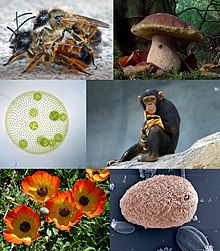Eucaryote
 |
| Classification scientific |
|
|
| Eukaryota (Chatton, 1925) Whittaker & Margulis, 1978 |
Eucaryotes es organismos vivente cuje cellulas ha nucleos e altere organellos delimitate per membranas. Illos forma un dominio (nomine scientific Eukaryota del greco: ευ/eu, bene o vere + κάρυον/karyon, nuce o nucleo con suffixo -ώτης (-ṓtēs)), un del tres in que tote le vita cellular es dividite. Illos include animales, plantas, fungos e alcun altere organismos unicellular (protistos) o multicellular.
Supertaxones
[modificar | modificar fonte]Phylogenia
[modificar | modificar fonte]Se pensa que le prime eucaryotes se formava de un archeo con endosymbiose (fr) de al minus un α─Proteobacteria (devenite su mitochondrio).
Le prime protistos cognite haberea vivite desde 2.1 milliardos de annos in le deposito de Moulendé (en) in Gabon.[5] Le horologio molecular (en) indica un edade del ultime eukaryotic commun ancestre (LECA (en)) inter 1.2 e 1.8 Ga (milliardos de annos).[6] Lor apparition haberea essite favorisate per le Grande Oxydation evento (2.4 Ma - 2.0 Ma).[7]
| Eukaryotes |
| ||||||||||||||||||||||||||||||||||||||||||||||||||||||||||||||||||||||||||||||||||||||||||||||||||||||||||||||||||||||||||||||||||||||||||||||||||||||||||||
- ↑ "Towards a natural system of organisms: proposal for the domains Archaea, Bacteria, and Eucarya" (June 1990). Proceedings of the National Academy of Sciences of the United States of America 87 (12): 4576–4579. doi:. PMID 2112744. Bibcode: 1990PNAS...87.4576W.
- ↑ Margulis, Lynn (6 February 1996). "Archaeal-eubacterial mergers in the origin of Eukarya: phylogenetic classification of life". Proceedings of the National Academy of Sciences 93 (3): 1071–1076. doi:.
- ↑ "Microbial predators form a new supergroup of eukaryotes" (December 2022). Nature 612 (7941): 714–719. doi:. PMID 36477531.
- ↑ "Revisions to the Classification, Nomenclature, and Diversity of Eukaryotes" (January 2019). The Journal of Eukaryotic Microbiology 66 (1): 4–119. doi:. PMID 30257078.
- ↑ A. El Albani, K.O. Konhauser, A. Somogyi, J. Ngwalghoubou Ikouanga, A. Lamboux, J. Blichert-Toft, E. Chi-Fru, C. Fontaine, A. Mazurier, A. Riboulleau, A.-C. Pierson-Wickmann, F. Albarède, "A search for life in Palaeoproterozoic marine sediments using Zn isotopes and geochemistry", Earth and Planetary Science Letters, volume 612 (2023) DOI:10.1016/j.epsl.2023.118169
- ↑ Brocks, J.J., Nettersheim, B.J., Adam, P. et al. (2023-06-07). "Lost world of complex life and the late rise of the eukaryotic crown" (in en). Nature. doi:.
- ↑ doi:10.1111/gbi.12576










